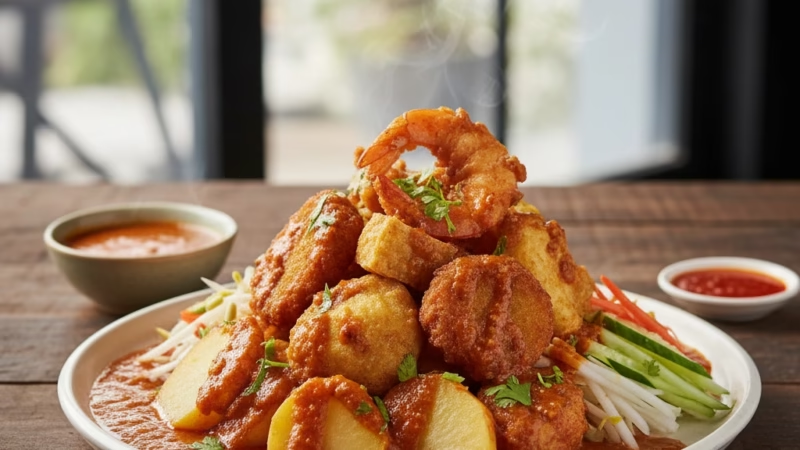Pasembur (Indian Rojak)

Malaysian Food
Pasembur, also known as Indian Rojak, is a Malaysian street food featuring a mix of shredded vegetables, fried seafood, and tofu served with sweet-spicy peanut sauce.
Origin
Malaysia, primarily Penang and northern states; influenced by Indian Muslim and Peranakan cuisines.
Category
Street food / Salad / Snack / Malaysian fusion cuisine
Appearance
Colorful mix of shredded cucumber, turnip, bean sprouts, fried tofu, seafood fritters, and sometimes hard-boiled eggs, drizzled with dark brown peanut sauce and garnished with chopped peanuts and herbs.
Ingredients
- Shredded cucumber, jicama/turnip, bean sprouts
- Fried tofu, prawn fritters, crab sticks
- Hard-boiled eggs (optional)
- Peanut sauce (peanuts, chili, garlic, tamarind, sugar)
- Fresh coriander or spring onions
Preparation
- Shred vegetables.
- Fry tofu and seafood fritters until golden.
- Assemble vegetables and fried items.
- Drizzle with peanut sauce.
- Garnish with peanuts and herbs.
Equipment
- Fryer or wok
- Knife and chopping board
- Mixing bowls
- Spoon for sauce
Variations
- Penang style: More seafood and crispy fritters
- Kuala Lumpur style: Slightly sweeter peanut sauce
- Vegetarian version: No seafood, only tofu and vegetables
Taste
Sweet, savory, nutty, slightly spicy, tangy
Texture
Crunchy vegetables and fried items; creamy peanut sauce
Aroma
Nutty and savory with hints of chili and garlic
Sound
Crunchy bite from fried items and fresh vegetables
Cultural Significance
Represents Malaysian street food culture and Indian-Muslim culinary influence
Symbolism
Blending of Indian and Malay culinary traditions
Regional Cuisine
Penang, Perak, and northern Malaysian states
Social Context
Popular as a snack or light meal; often enjoyed at hawker centers and markets
Nutritional Information
Protein from seafood and tofu, fiber from vegetables, fats from peanut sauce
Health Benefits
Provides essential nutrients, protein, vitamins, and minerals; high in fiber
Dietary Restrictions
Contains peanuts; may contain seafood; not vegan if sauce contains fish-based ingredients
Allergens
Peanuts, seafood, gluten (if batter contains wheat)
Cost
Affordable street food: RM8–15 per serving
Production
Made fresh daily by street vendors using local vegetables and seafood
Sustainability
Depends on seafood sourcing; local vegetables reduce environmental impact
Availability
Hawker centers, street stalls, and Indian Muslim restaurants in Malaysia
History
Evolved from Indian-influenced rojak dishes brought by Indian Muslim immigrants to Malaysia
Anecdotes
A local favorite in Penang; often eaten as a late-night snack with friends
How to Prepare
- Shred vegetables.
- Fry tofu and seafood fritters.
- Arrange on a plate and drizzle peanut sauce.
- Garnish with peanuts and herbs.
- Serve immediately.
FAQ
- Is it spicy? Mild to moderate, depending on the sauce.
- Can it be vegetarian? Yes, omit seafood.
- Where is it best eaten? Street stalls in Penang, like Gurney Drive or Butterworth.








Comments are closed.